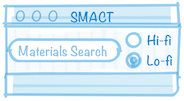Compositional Screening: Mapping Chemical Space#
Now that you understand chemical filters and their ability to eliminate impossible combinations, it’s time to take a systematic approach to exploring specific regions of chemical space. Compositional screening is the process of comprehensively mapping all possible compositions within a defined chemical system—think of it as creating a detailed atlas of what’s chemically feasible.
From Filters to Systematic Exploration#
In the previous sections, we learnt:
How combinatorial explosion creates vast possibilities
How chemical filters eliminate the impossible
How to apply individual filters step by step
Compositional screening builds on these foundations to tackle a fundamental question: “Within a specific chemical system, what compositions are possible, and which ones actually exist?” It’s the difference between knowing that some materials might exist and systematically cataloguing what’s truly achievable.
What is Compositional Screening?#
Compositional screening involves:
Defining a chemical system (e.g., Cu-Ti-O for oxide semiconductors)
Generating all possible compositions within that system
Applying comprehensive chemical filters to identify viable candidates
Comparing with known materials from databases like the Materials Project
Visualizing the results to understand the accessible compositional space
Why This Matters for Materials Discovery#
Consider searching for new solar cell materials in the Cu-Ti-O system:
Raw possibilities: Thousands of compositions
After chemical filtering: Hundreds of viable candidates
Known from experiments: Dozens of actual compounds
Gap analysis: Which filtered compositions haven’t been made yet?
This gap represents unexplored opportunities for new materials discovery. It’s where the next breakthrough might be hiding—compounds that are chemically sensible but simply haven’t been synthesised yet.
What You’ll Learn#
In this section, we’ll explore:
How to systematically generate compositional spaces
Advanced filtering using multiple oxidation state sets
Comparing theoretical predictions with experimental reality
Creating ternary phase diagrams to visualise chemical space
Using oxidation state probability analysis to refine predictions
Identifying the most promising unexplored compositions
The Cu-Ti-O Case Study#
We’ll use the Cu-Ti-O system as our example because it demonstrates:
Industrial relevance: Important for photocatalysis and solar cells
Chemical complexity: Multiple oxidation states and phases
Data availability: Well-studied with known Materials Project entries
Visual appeal: Perfect for ternary phase diagram visualisation
Building on Previous Knowledge#
This section builds directly on our previous work:
Combinatorial Explosion taught us the scale of chemical space
Chemical Filters showed us how to eliminate impossibilities
Compositional Screening now shows us how to map what remains
Tools You’ll Master#
By the end of this section, you’ll be comfortable with:
SMACT’s oxidation state filtering capabilities
Materials Project API integration for validation
Ternary plot visualisation of chemical spaces
Oxidation state probability analysis
Systematic comparison of theory vs. experiment
Ready to map your first chemical space? In the follow-along notebook, we’ll take you through a complete compositional screening workflow using the Cu-Ti-O system. You’ll learn to generate theoretical compositional spaces, apply chemical filters, query experimental databases, and create compelling visualisations that reveal opportunities for new materials discovery.
Open the companion notebook to begin your hands-on exploration of chemical space!
